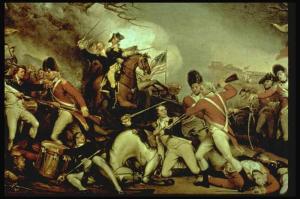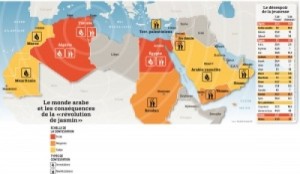Hello all! Welcome once again to “What’s the Deal”, the blog that covers current events through a historical perspective, and makes you cringe at the low quality of my jokes and my sarcastic comments.
Since it is that special time of year when the United States celebrates the signing of the Declaration of Independence on July 4 1776 (not the actual vote for independence, which took place on July 2), I thought the patriotic thing to do would be to party on the 4th and watch fireworks, and then work on a blog about the American Revolution. So what’s the deal with trying to compare the Arab revolutions of 2011 to the American Revolution of 1776? They’re completely separate time periods, the American revolution is an uprising against a colonial ruler 3,000 miles away, the revolutions in the Arab world have been relatively short, and with the exception of Libya, have avoided a long drawn out war for independence. So, where are the connections? Or am I just stalling for time? (frantically searching for evidence that there is a connection)
Well, the easiest connections to make are the causes of unrest and the impetus or desire for revolution in the first place. In all the cases of revolution presented here in Tunisia, Egypt, Libya, Syria, and the American Revolution, there was a perceived breach of human rights by an overbearing autocratic government. Let’s look at the American Revolution first, and look at the main reasons for the rebellion to occur, and how the Americans worked to address those specific grievances in the Declaration of Independence and in the Constitution of 1787/Bill of Rights.
In the years leading up to the American Revolution, the great majority of dissent came from merchants (many from Boston) who began to get taxed more heavily (because the British needed the extra $ to support further military presence in the American colonies). British legislation was directed at the colonies to generate more revenue from taxes were put into law, such as the Stamp Act (1765), the Townshend Acts (1767), and the Tea Act (1773). Not just the merchants, but the rest of the colonists also were exhausted of being forced to pay for and house British soldiers in their houses, a constant reminder of the King’s strong hand in enforcing order. The Quartering Act (1765) required the colonies to provide quarters or housing and food for British troops in the American colonies.
The Coercive Acts a.k.a the Intolerable Acts (1774) were a direct result of the Boston Tea Party and closed Boston Harbor, extended the British Canadian border to the Ohio River, banned town meetings w/o colonial government consent, and protected local British officials from legal suits in the colonies (instead having the trial occur in England, where there is a more friendly judge and jury). It is no surprise here that in 1774, the First Continental Congress convened and agreed to oppose the Coercive Acts and write ten resolutions that spell out the rights of the colonists to “life, liberty, and property.”
So, many colonists believed they were *being taxed unfairly (this is a point for debate), *pushed around by the strongest military in the world, and *sanctioned too much for rebellious behavior. Let’s see what Jefferson accuses King George III (and not British Parliament, surprisingly) of doing in the Declaration (I won’t read all 28 accusations, but here are a few important ones to remember):
- He has kept among us, in times of peace, Standing Armies without the Consent of our legislatures and For quartering large bodies of armed troops among us
- For imposing Taxes on us without our Consent
- For depriving us in many cases, of the benefit of Trial by Jury and For transporting us beyond Seas to be tried for pretended offenses
The third Amendment of the Constitution directly correlates to the first two grievances listed, “No Soldier shall, in time of peace be quartered in any house, without the consent of the Owner, nor in time of war, but in a manner to be prescribed by law”. Amendments 5, 6, and 7 were written to protect the rights of those who had not been given fair trials, punished or imprisoned wrongly. These accusations are the impetus for the revolution summed up in the Declaration and are the direct violation of the recognized rights of the colonists as free people. The imposition of taxes without consent were reasons to be angry with the British Crown and reason to say their rights had been infringed upon by an overreaching monarch.
Now let’s make the big leap of faith and connect the American Revolution and War for Independence with the Arab countries that have been or are currently experiencing a revolution (I unfortunately am not going into all the details of why each of the respective revolutions occurred, but just looking at some key points that interestingly enough connect to the American revolution). Are you excited? I know I am.
In Tunisia, an 23 year long rule by Zine el-Abidine Ben Ali filled with corruption and public repression came to an end in January of this year in the “Jasmine Revolution.” The huge protests that came about were stimulated by an economic stagnancy that spread from Europe to Tunisia, and a reason to protest the authoritarian government. The protests that brought the downfall of Ben Ali were driven by a want for basic human rights that had been withheld. These included torture and imprisonment without a fair trial. Dissidents of the Ben Ali regime were subject to this treatment and we can easily see a connection to the American colonists’ desire for revolution.
In Egypt, a very similar story took place as 30 years of the Hoshni Mubarak regime came to an end after large-scale protests took place. Incited by the success of the Tunisian revolution, the protesting Egyptians sought to oust an authoritarian regime of their own and forced Mubarak’s resignation on Feb. 11. One of the main points of contention that Egyptians had with the Mubarak regime was the over extension of the Emergency Law protocol in place to “combat terrorism”, but something that actually limits individual basic freedoms such as allowing police to arrest and imprison people without charge, limit freedom of expression and protest, and hold a special security court. These are clearly limits of a citizens right to a fair trial, justice, and freedom of expression.
In Libya, the revolution and ongoing war for independence began in February with protests calling for the ousting of Chief of State Col. Muammar Qaddafi who had held power since a coup in 1969. The protests against Qaddafi’s government came largely from economic discontent where in the beginning of 2011, Libya was experiencing 30% unemployment. The biggest connection to the American Revolution is that the Libyan revolution is the only Arab revolution to reach the status of a war for independence with a rebel force fighting Libyan and foreign forces fighting for the state. Like the Continental Army of the American War for Independence (1776-1783), the Libyan rebel forces are for the most part a varied, disorganized, and inexperienced armed force. Also like the American rebels, the Libyans have foreign military help. France was to the American rebels what NATO forces are to the Libyan rebels.
The story in Syria is covered by my previous blog entry on Syria but the story is similar to the others where mass protests incited by other regional uprisings have called for an end to a repressive/authoritarian regime, in this case the al-Assad family regime of 40 years. The violent crackdown Bashar al-Assad’s government and military on free speech and peaceful protests by as well as the use of heinous total war tactics like rape and full scale death and destruction are similar violations of human rights that Syrians (and the rest of the world) want to see an end to.
I won’t get into the protests and smaller uprisings in Algeria, Bahrain, or Saudi Arabia but we can sum up the Arab revolutions of 2011 as a massive movement motivated by economic stagnancy and a repressed population that has been denied their basic rights for a long time. The protests have all centered around ousting a longstanding oppressive and authoritarian regime that has used suppression and violations of basic human rights to quell dissidents.
Ok Eric, you’re saying, the game is up. You’ve been rambling on for pages and you’re really just using a common sense conclusion to describe the circumstances surrounding anyrevolution, not a substantial connection to the American Revolution specifically.
Well, to that angry reader’s retort, I reply… Yes, that is essentially a general description of how revolutions usually begin: a fed up populace that feels they have been mistreated and underrepresented. This description includes the American Revolution, and there are specific points from the American Revolution that I believe correspond very well to the Arab Revolutions. Also, the creation of the Declaration of Independence and the Bill of Rights from the American Revolution provided other countries the idealistic blueprint for basic human rights.
Conclusion: Ok, here are the main connections between the American Revolution and the Arab Revolutions of this year.
- An authoritarian monarch or leader ruling a population with a heavy hand for an extended period of time.
- Mistreatment of citizens and violations/suppresion of basic human and civil rights
- Difficult economic environment that incites a population to protests or revolt against the government
- (In the case of Libya) A foreign power helping the war for independence
This blog did not examine specifically the up to date current status of the revolutions, and I feel if I had more space, I could really compare the unfolding of each of the revolutions to the American revolution.
Well, thanks again for tuning into another edition of “What’s the Deal?” I hope you enjoyed it, and please feel free to comment derisively or in adulation. Tune in next week when we talk about something topical and then give it the ol’ history treatment.
Your Faithful Historian,
Eric G. Prileson
Sources:
For information on the Arab Revolutions, check out each country’s page on the New York Times Online Times Topic page.
For references on the American Revolution, a subject that I am very familiar with, I referenced the Almanac of American History (edited by Arthur M. Schlesinger Jr.) for details as well as the official text of the U.S. Constitution and Declaration of Independence on the U.S. Government website.








You have great jokes- you’re punny, remember?